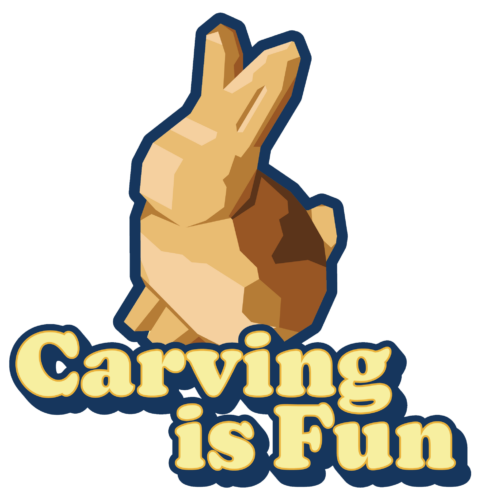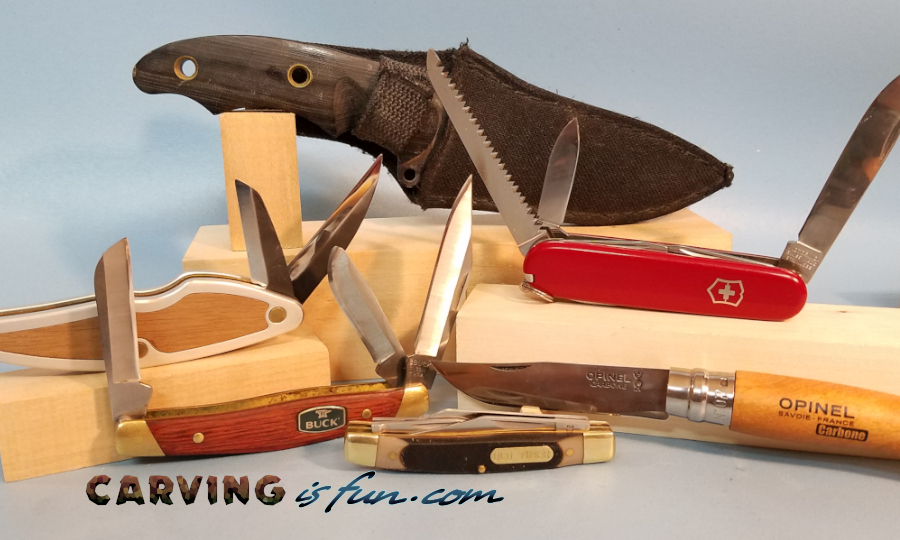Quite a few people have a preferred every day carry (EDC) knife that they take with them for a variety of reasons. Some have them for emergencies while others like having access to a useful tool to open a bag or container with.
As your EDC knifes are with you every day, you might find yourself with some free time, a comfortable place to sit, and a stick to whittle. It’s times like these that having even a basic pocket knife can make the day that much more enjoyable and let your creativity run free.
Just about any pocket knife can be used for whittling, but if you do plan on using your EDC knife for whittling I would recommend using one made with quality steel and keeping it sharp.
Picking the Right Knife
When whittling, your carving is only as good as your knife. Using a pocket knife that dulls easily or is just unfamiliar to you can lessen the overall experience.
You also have to consider how this knife is going be carried around with you every day. If it is uncomfortable or difficult to manage, you may not even bother putting it in your pocket when you leave your house.
Use a Familiar Knife
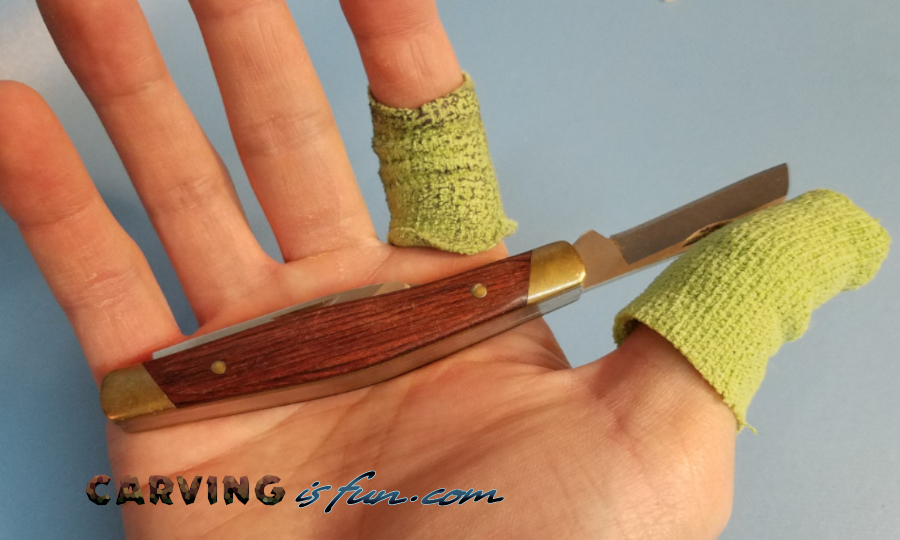
My biggest tip for anyone whittling with an EDC knife is to get familiar using and manipulating the blade. Detailed whittling will require you to handle and manipulate the knife in a variety of ways that you may not be use to.
If the knife doesn’t fit your hands properly, you may have a harder time controlling the blade or even cut your fingers! For me, I find that I like the knife handle to extend from one side of my palm to the other. A little overhang is fine, but any smaller I have a harder time safely handling the knife.
Learn to cut small details with the knife and pay attention to how you are holding both the knife and the wood you are whittling. This will help prevent you from taking off too much wood or injuring yourself.
How Will You Carry This Knife?
If you are going to add an extra knife to your EDC loadout for whittling, just keep in mind how you are going to carry this tool with you.
Personally, I like to carry several knives with me to fill a variety of different tasks. When carrying these knives I have to consider how they will be stored on my persons in an easy to reach place while not interfering with my wallet or keys.
Cargo pants are a great way to help spread the load out, but a nice belt with clasping sheaths are how I carry 2 of the 3 knives on me every day. They are easily accessible, out of the way, and aren’t banging around in my pocket when walking around.
Knives with clips are perfect for easily slipping in your pocket and keeping them accessible at the same time. My 3rd knife is kept in my back pocket and is my usual go to for if I need an accessible knife quickly.
Recommended EDC Whittling Knives
If you are looking to pick up a great EDC knife for whittling or just picking up your first pocket knife, here are some excellent options that are great for both every day use and whittling.
– Opinel Carbon Steel Folding Knife
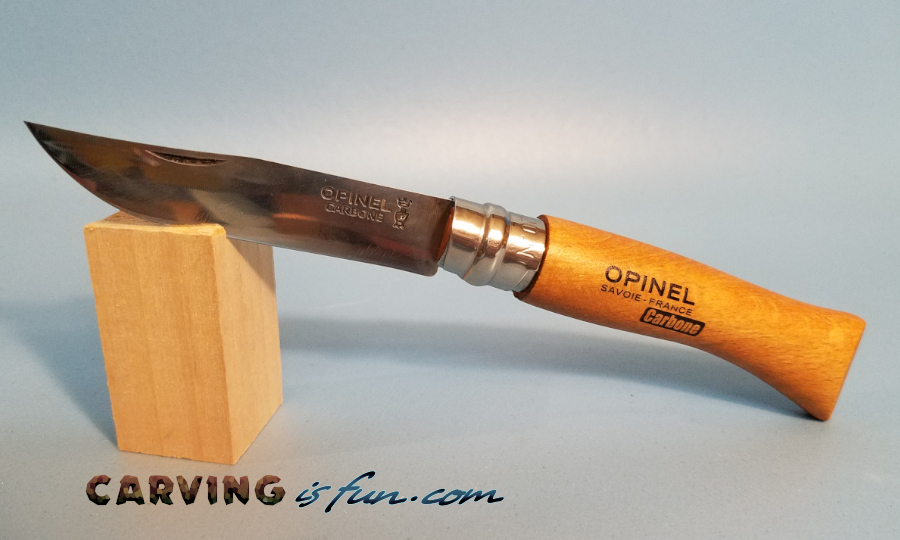
Opinel makes a super affordable, comfortable to hold, and highly effective pocket knife that is superior to any other knife in its price range. This knife has great edge retention, is light weight, folds up nicely, and comes with a highly effective blade lock feature that feels like a fixed blade knife.
If you want a different size, I recommend getting no smaller than a No. 6 as the smaller sizes don’t come with the blade lock feature.
You can pick these up for a steal of a price on Amazon, click here to pick one up for yourself!
For my full review on Opinel folding knives, click the link below:
https://carvingisfun.com/opinel-carbon-steel-knife-review/
– FlexCut Whittlin’ Jack
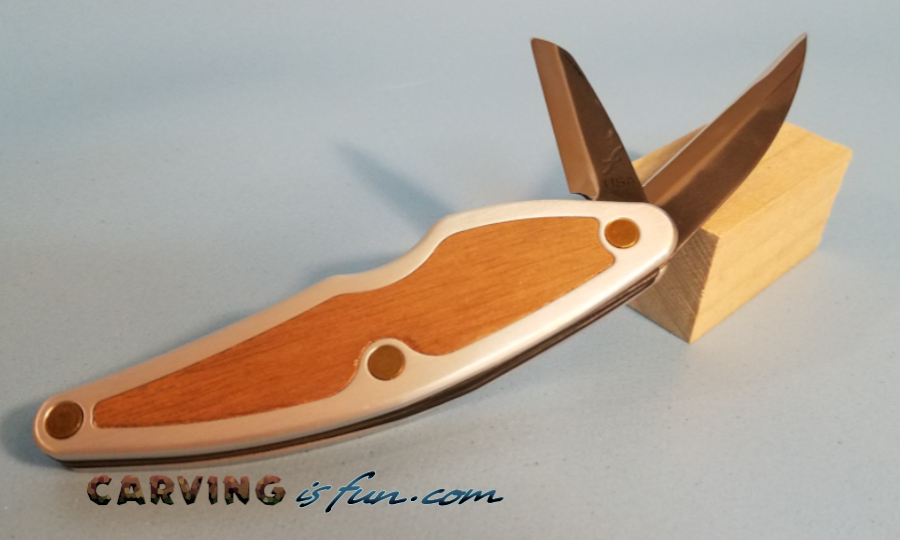
If you are looking for a purpose built folding whittling knife, the FlexCut Whittlin’ Jack is the knife to get! This is a portable whittling knife for wood carvers on the go, making it perfect for hikes and camping trips.
I rotate this knife out with my Opinel if I want something different to whittle with that day. This knife offers me more options for more detailed work than a standard folding knife.
These are easily found for a good price on Amazon, click here to pick one up for yourself!
For my full review on the Whittlin’ Jack, click the link below:
https://carvingisfun.com/flexcut-whittlin-jack/
– Victorinox Camper Swiss Army Knife
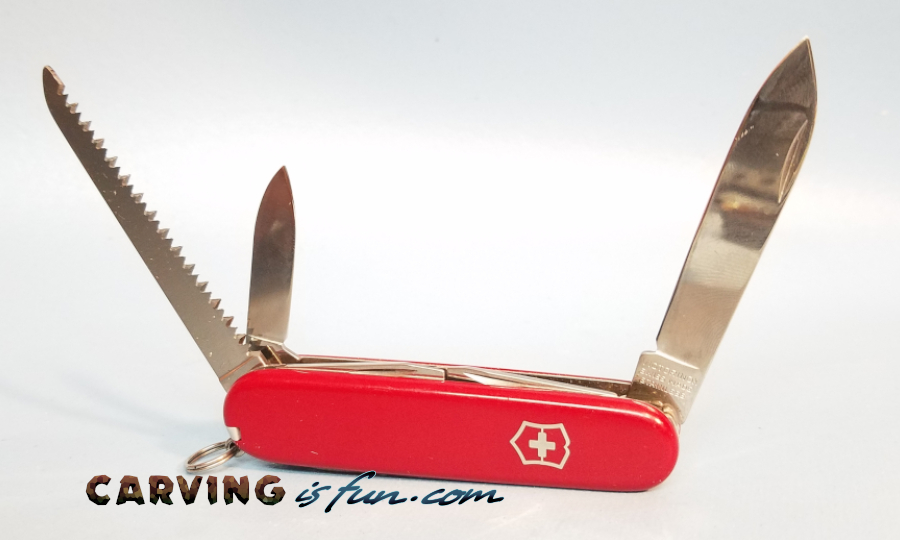
The Swiss Army Knife is an iconic tool that Just about everyone has heard of and probably already has. Victorinox makes a wide variety of different Swiss Army Knives, but I have found the Camper to be my ideal version for whittling on the go.
With the two different sized knives and the saw, you can easily shape most any stick and small piece of wood in a variety of ways. Plus, these knives come with several other tools that make them an ideal companion for every day use.
Swiss Army Knives are quite affordable and easily picked up on Amazon, click here to pick one up for yourself.
What Makes a Good Whittling Knife
All knives are not made the same, they will have different quality steel, vary in build quality, and come in various shapes and sizes. Picking the right knife for you may take some research and actual time in your hands.
Steel Quality
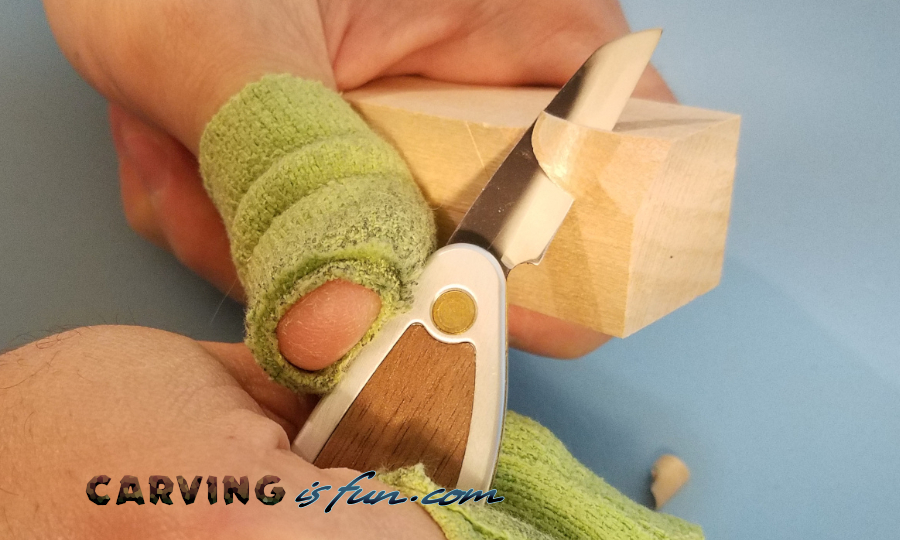
The first and most important trait of a good whittling knife is the quality of the steel. If the steel is too soft or just made of an inferior metal, you won’t be able to make and hold a razor sharp edge.
Using quality steel offers you the benefits of being able to easily whittle for long periods of time without constantly sharpening and honing your blade. Keep in mind that these knives will typically cost more money, but are worth every penny if you are a serious whittler.
Try and find a knife with a Rockwell Hardness rating between 58 and 62. This is the “sweet spot” for whittling as the knives are hard enough to hold an edge but not so hard that they become brittle.
For more information on this topic, check out my more in depth article with different brand knives to compare against by clicking here.
Blade Design
Each person will have their preferred blade design for whittling, some like a curved blade while others like a flat cutting edge. The only real way to know what is best for you is by just trying them out for yourself.
My personal preference is a flat cutting edge like the FlexCut Whittlin’ Jack pictured above. It provides a consistent cutting edge and is really easy to hone so I can quickly get back to whittling.
Blade Thickness
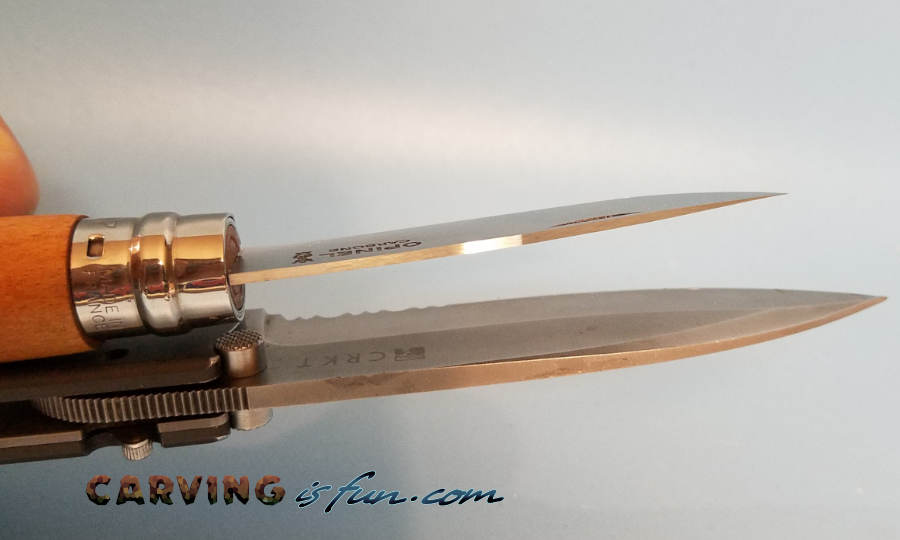
For many people, the thickness of the blade may not seem like a key factor to an effective whittling knife. But the difference can be quite substantial when making push cuts and shaving off thin slivers of wood.
Using a thinner knife for whittling reduces the force needed to push the blade through the wood. You are essentially pushing a thin, sharp wedge through the wood vs a thick sharp wedge.
Not only that, the thinner knives will have more of a razor sharp cutting edge if honed properly. This allows the blade to just glide through the wood like butter. If you get the chance, try out a knife like the Opinel Carbon Steel Folding Knives and see how much of a difference it can make compared to your regular EDC knife.
Locking and Fixed Blade Knives
Anyone who has used used a folding knife without a blade lock mechanism for a long period of time has had the blade close on their finger during use. I had this happen to me when I was younger and immediately asked my dad for a new pocket knife that locks.
Now, I have both fixed blade and locking blade knives for various applications. I personally enjoy the security and comfort of knowing my knife will not fold on my fingers, especially now because they are sharper than ever!
There are ways to protect your fingers on the go, and will be discussed a bit further down.
Overall Build Quality

After owning dozens of knives from your bargain bin junk to beautiful hand crafted knives, it is easy to tell when a knife is built poorly and with little consideration for it’s intended use.
We all have heard the saying “you get what you pay for” and is extremely true in the knife industry. There may be some exceptions for custom made knives (you are buying a one off knife making it even more special) but there is a reason why some variety’s are more expensive than others.
Take the picture above. Some cheaper knives, like the Old Timer pocket knives by Schrade, are cool at face value but have some serious flaws when actually putting them to real world use. The Splinter Carving knife shown in the picture uses a lower quality steel that has a lot of flex in the blade. This can lead to less than ideal carving results, poor edge retention, or even injury.
Dedicate at Least One Blade to Whittling
Some people like myself will carry multiple single blade knives with each one having it’s own intended purpose. Others prefer carrying multi blade knives to reduce their loadout weight and bulk. Either way is perfectly acceptable and still allow you to have at least one dedicated blade for whittling.
A great way to make sure you always have a sharp knife available for whittling is to dedicate at least one knife, or one blade in your knife, to just whittling. This way you can shape this knife to your preferred cutting edge and keep it honed razor sharp.
More Blades = Less Sharpening
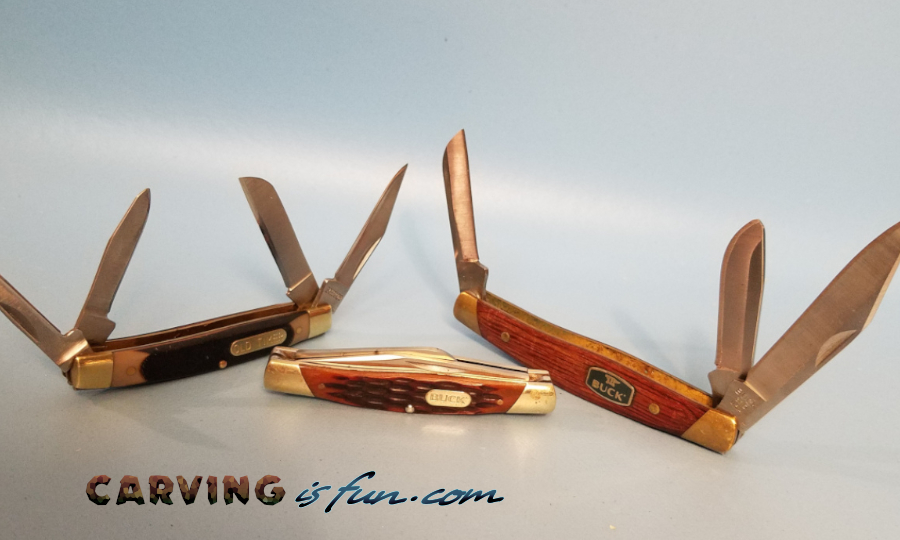
Most of you who have carried knives and use them every day will agree with me that more is better. I have on multiple occasions dulled out one knife to the point that it was useless in the matter of hours. During these times, I just pull out another blade or knife and continue what I was doing.
When you are out and about, you probably won’t have access to an ideal knife sharpening tool. You can carry a portable one with you, but those will usually only get you so far.
Simply having a backup knife or an EDC knife with multiple blades in them will keep you whittling or working for much longer period of time without having to stop and sharpen the blades.
Carry an Extra Knife

Personally, I have found it quite easy to add another knife to my EDC loadout. By either purchasing a knife with a clip on it, a clasping sheath, or just making use of a free pocket, you can carry that extra tool you want to carry.
My favorite way to carry my tools is on my belt. This keeps the tools up and out of the way and they aren’t crowding my pocket or bouncing on my leg. Sheaths can be found at a great price online, just pick up the leather ones as I have found them to last longer than the canvas variants.
Portable Knife Sharpening Tools
Let’s face it, your knife will get dull if you use it enough and sharpening your knives on the go can be hard to do.
The best ways I have found to sharpen my knives on the go is to either make my own portable sharpening tools or buying special made portable sharpening stones. Either way works, just pick a method that best suits you.
Sandpaper Glued to a Flat Surface

Making your own sharpening tool out of sandpaper and a thin ridged piece of wood or ridged plastic is the most economical and simplest way to have a pocket sized way to keep your knives sharp.
The picture above was made from a ridged piece of scrap wood and 1000 grit wet dry sandpaper. I just cut out the size I needed and glued them together for an effective sharpening block on the go.
Small Leather Strop
Just like the sandpaper block you can find a small piece of leather, load it with polishing compound, and take it with you where ever you go. Keep in mind, the polishing compound may get messy so keeping it in a small ziploc bag may be a good idea.
Sharpening Stones
The best way to go about this is to buy purpose made portable sharpening stones and diamond plates. However, this can get quite pricey as these tools can cost anywhere between $10 to $50 depending on how fine you need them and what they are made of.
I myself like the DMT Mini Sharp Extra Fine Diamond Knife Sharpener as you can just attach it to your key chain or slip it into a pocket. They can be purchased for a great price on Amazon by clicking here.
Portable Finger Protection

Folding knives have the potential to close on your fingers when you least expect it. Thankfully there are a few easy and cheap ways to your knives from cutting your fingers. Both can be easily slipped in your pocket or sheath with the knife for immediate use and help prevent injury.
Athletic Tape

My preferred way to protect the tips of my fingers is by using self adhering athletic tape. You can pick these up by the roll from your local convenience store for less than $10 and can be customized to securely fit your fingers.
For me, the best way to store them on your persons is by slipping them off my fingers and sliding them over the knife itself before placing it into my pocket or sheath. They are reusable and you don’t need to unwrap them at all, just slip them off and put in your pocket.
Finger Guards
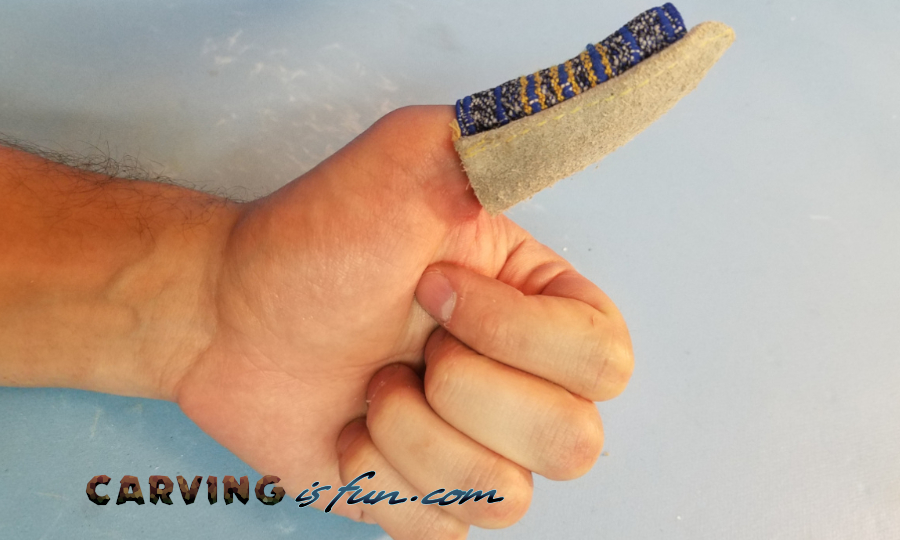
You can also use finger guards with leather palms, but I have found them to be less form fitting and more ridged than the athletic tape. Not only that, they can be a bit more expensive to purchase than the athletic tape.
Still, they are great options and I think the leather palms may be more cut resistant than the athletic tape.
Easy Whittling Projects with an EDC Knife
Now that you have your preferred EDC whittling knife, what should you whittle? You probably won’t be sitting down for over an hour whittling and if you don’t have a sharpening tool, that window of having a shapr knife may end up being much smaller than anticipated.
Here are a few fun and simple whittling suggestions to provide inspiration to the whittler on the go.
Simple Fish

Fish are easy, fun, and satisfying to whittle. You don’t need to add a whole lot of detail to them to be recognizable and can easily be done with a stick found on the ground or cut from a tree.
The one above was about 3 inches long and took me about 15 minutes to make. The best part is, I didn’t even have to hone my knife after I was done! Just make sure you find some wood soft enough to carve it could rapidly dull out your knife if the wood is too hard.
Quick Canoe with Fishing Bear
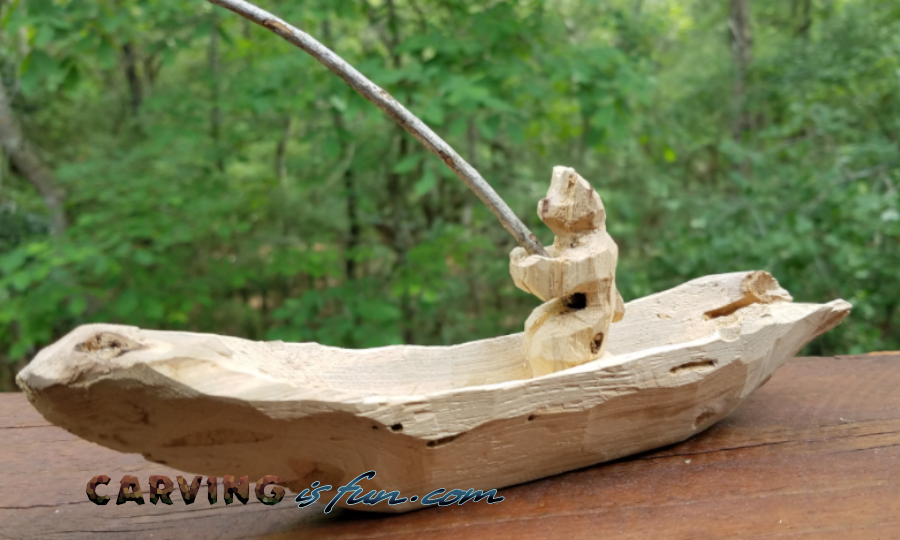
This was a fun and easy whittling project! I found a really cool looking, bug eaten branch that was soft and ready to whittle. It only took me about 30-40 minutes to make the canoe and another 20 or so minutes to make the fishing bear.
You can just get creative with these projects and you don’t have to make them perfect. Matter of fact, I think my canoe looks even better in its more “rustic” look to it.
Spoon

Spoon carving is a simple and enjoyable process that can be done with a knife. You may have to get a little creative with the concave portion if you don’t have a hook knife on you but it can be done without one.
If you are camping, this becomes a useful utensil to use if you forgot to pack some silverware.
More Easy and Fun Whittling Ideas
If you want some extra whittling inspiration complete with instructions, check out my Step-By-Step Whittling guides. I am constantly adding more to the list as I find more fun and interesting projects to whittle.
